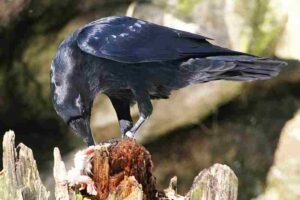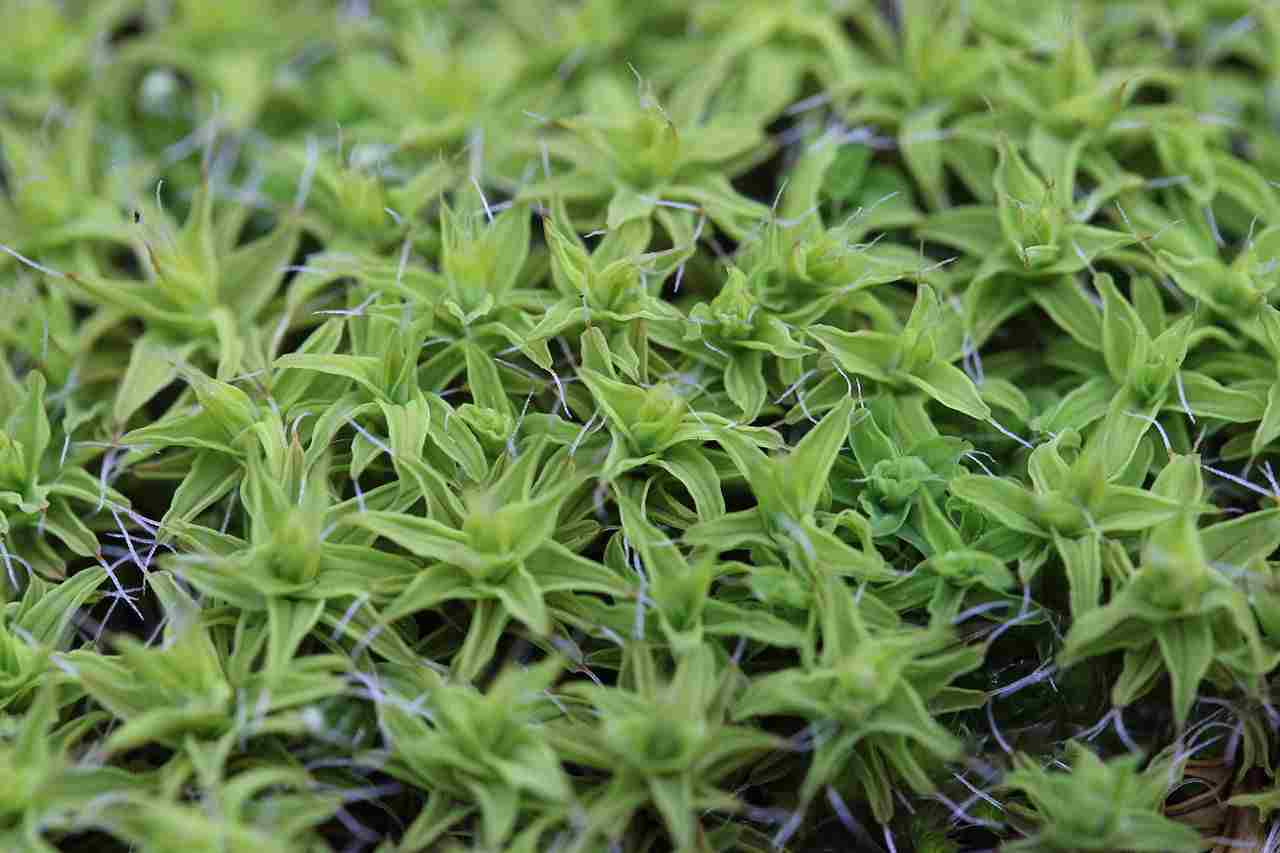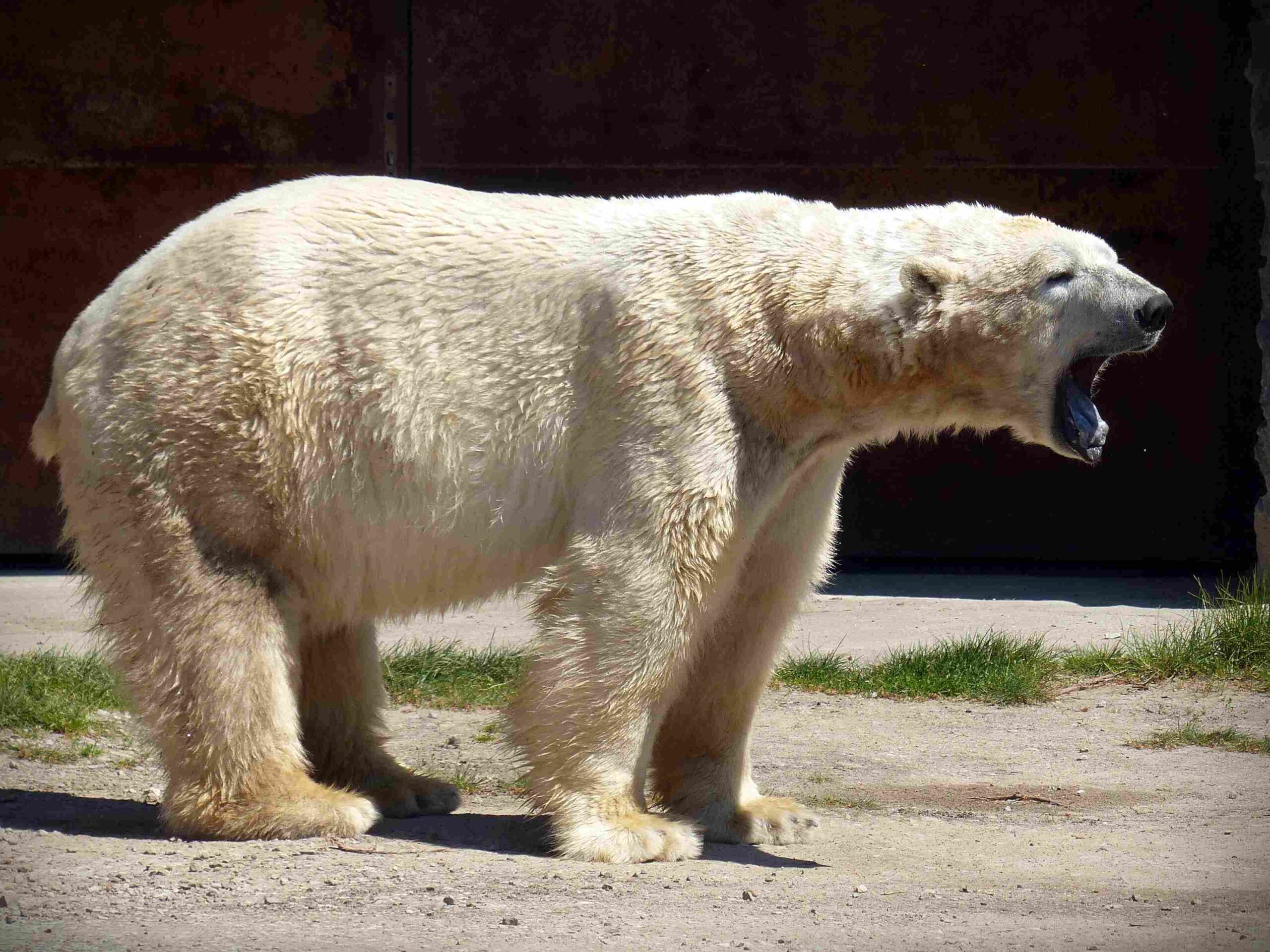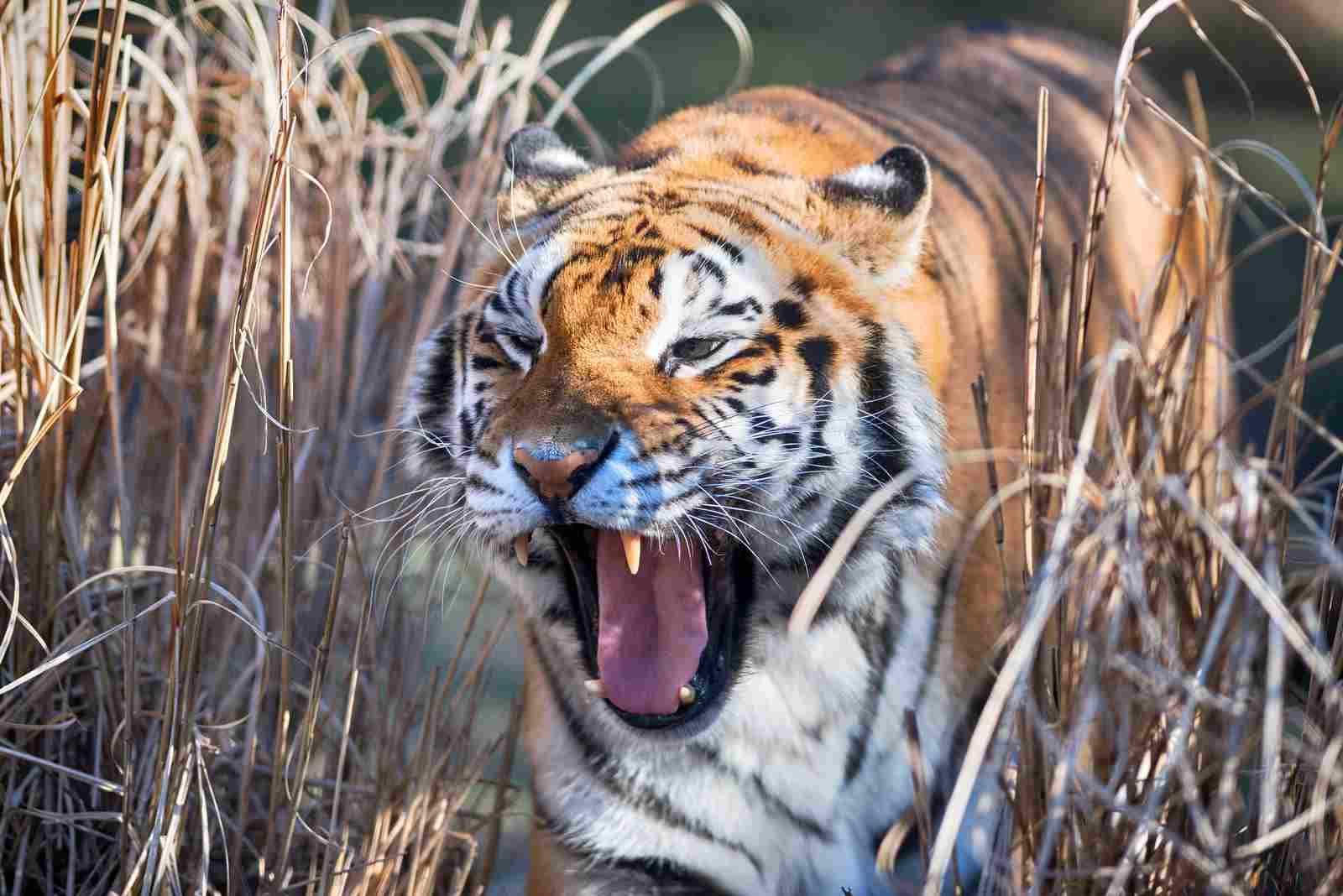Biotic factors in the Arctic are; autotrophs like lichen, herbivores like Arctic hare, carnivores like polar bear, omnivores like glaucous gull, decomposers like fungi, as well as the trophic relations between these organic groups.
This article discusses biotic factors in the Arctic ecosystem, as follows;
1). Arctic Autotrophs (as one of the Biotic Factors in the Arctic Ecosystem)
Autotrophs are organisms that are capable of producing their own food using solar energy in the form of light (as in photosynthesis), or using inorganic compounds as raw materials (as in chemosynthesis) [6].
In the harsh, extreme conditions of the Arctic biome, autotrophs form the foundation or basal level of the food chain, from where they supply biomass (food, energy, nutrients) to support the entire ecosystem.
Examples of Autotrophs in the Arctic
Examples of autotrophs in the Arctic include algae, vascular and non-vascular plants like; Arctic algae, shrubs, grasses, lichens, and mosses. It must be noted that the cold, desert-like nature of many locations in the Arctic region does not support significant tree growth [7], so that dense forest areas are generally absent.
Below is a concise discussion of each example listed above;
1. Various species and forms of algae, including benthic (aquatic) algae, and free-floating phytoplankton, are known to thrive in Arctic water bodies.
They are important autotrophs due to their immense contribution to primary production in marine ecosystems
2. Dwarf shrubs that occur as autotrophs in the Arctic region include; Arctic blueberry (Vaccinium uliginosum), and Arctic willow (Salix arctica) [1]
The adaptations of these Arctic plants enable them to withstand the low temperatures of their habitat, so that they can grow effectively and serve as food sources for local herbivores
3. Grasses like Cotton Grass (Eriophorum scheuchzeri), and Arctic Sedge (Carex arctogena) are fairly common autotrophs in the Arctic tundra.
They are important components of Arctic vegetation, and also serve as food for herbivores

4. Lichens are symbiotic, photosynthetic organisms that consist of a fungus and a cyanobacterium, or alga [2].
They can grow on different substrates including soil, tree bark, and rocks in the Arctic, making them versatile autotrophs.
5. Arctic mosses are bryophytes which occur in the form of small, non-vascular plants, and play an important role as primary producers in the Arctic tundra.
They are able to survive in extreme-cold temperatures and possess moisture-absorbing adaptations which allow them to absorb and retain water during the short growing season
*Status of Autotrophs as Biotic Factors
Autotrophs are considered biotic factors, because they are living organisms that contribute fundamentally to the ecosystem in terms of species richness/diversity, bioenergy and biomass production, energy transfer, and overall sustainability.
As primary producers, autotrophs convert electromagnetic radiation from the sun, or inorganic compounds (both of which are abiotic factors) into organic matter, which is the sustainable basis of the food chain/web.
*Overview of Autotrophs in the Arctic Tundra
The autotrophs in the Arctic tundra include; grasses, dwarf shrubs, algae, lichens and mosses.
These plants and algae posses unique adaptations for survival in the extreme cold, and short growing season of the Arctic environment.
As a result, they are essential for supporting the diverse wildlife and ecological processes in this region.
2). Arctic Herbivores
Herbivores in the Arctic are an important part of the ecosystem, as they function as primary consumers that depend on plant material as their main source of food.
Despite the challenging and harsh conditions, these animals have evolved diverse adaptive features to enable them survive in the extremely frigid Arctic zone.
Examples of Herbivores in the Arctic Ecosystem
Examples of herbivores in the Arctic ecosystem are; musk ox, Arctic hare, Arctic ground squirrel, caribou (reindeer), and Arctic willow ptarmigan. They are each discussed in the points below;
1. Musk ox (Ovibos moschatus) is a large herbivorous mammal that is native to the Arctic tundra.
This mammal's features include a hump on its back, and a thick layer of fur, for insulation against the cold.
Musk oxen also have a behavioral adaptation whereby they tend to form protective circles around their young, for defense against predators [5]
2. Arctic hare (Lepus arcticus) can be describe as a small herbivorous mammal that is highly-adapted to cold climatic conditions.
Its features include thick fur that is used to retain heat, color camouflage for eluding predators, as well as large, powerful hind legs for rapid and efficient locomotion across the snow-covered landscape
3. The Arctic ground squirrel (Spermophilus parryii) is another herbivorous rodent that is adapted to cold environments.
It survives by hibernating during the winter months [4] storing food in burrow-caches to sustain itself in the prolonged cold season

4. Caribou (Rangifer tarandus), also called reindeer; are large migratory herbivores that are known to travel long distances in search of food.
Their adaptive features include specialized hooves that enable them navigate efficiently across glacial terrains, as well as a specialized digestive systems that enable them extract nutrients from diverse plant materials including lichens
5. Willow ptarmigan (Lagopus lagopus) is a primarily-herbivorous specie of bird that inhabits parts of the Arctic tundra.
Its food includes plant materials like catkins and willow buds, and it has a distinctive plumage that alternates colors between winter and summer seasons to provide camouflage
*How Herbivores Survive in the Arctic
Herbivores survive in the Arctic by means of multiple specialized adaptations that sustain and protect them under extreme conditions. These adaptations include; specialized digestive systems, camouflage, thick fur (for insulation), seasonal migration, and social cooperative behavior.
They are each discussed briefly below,
1. Some Arctic herbivores, like musk oxen and caribou, have evolved specialized digestive systems that are able to achieve water conservation during digestion, and can cam nutrients from fibrous, tough plant materials
2. Several herbivores in the Arctic, including the ptarmigan and Arctic hare, possess light-colored or white fur/plumage that provides them with camouflage against the snowy landscape in winter, and alternates to darker shades in summer
3. Arctic herbivores may also possess thick fur that serves as insulating material and enables them operate under cold temperatures
4. Hibernation and migration are behavioral adaptations of herbivores like Arctic ground squirrels and caribou, which have evolved so that they have learned to hibernate and/or migrate during the winter months when climatic conditions are extremely harsh, and food resources are scarce
5. Herbivores, like musk oxen have also learned protective/defensive behavioral strategies like the formation of protective groups to shield their herds against predators, as well as for conserving/sharing body heat
*Overview of Herbivores that Live in the Arctic Ecosystem
Herbivores that live in the Arctic ecosystem include;
1. Arctic hares
2. Caribou or reindeer
3. Musk oxen, caribou
4. Willow ptarmigans
5. Arctic ground squirrels
These herbivores are well-adapted to cold climatic conditions, and play a critical role in shaping the dynamics of the Arctic ecosystem
3). Arctic Carnivores (as one of the Biotic Factors in the Arctic Ecosystem)
Carnivores in the Arctic are organisms that often function as predators, and are fully involved in maintaining the ecological balance of their habitat.
These animals rely on a diet that is mainly composed of meat, so that their survival is directly dependent on the availability of prey species in the harsh Arctic environment.
Examples of Carnivores in the Arctic Ecosystem
Examples of carnivores in the Arctic ecosystem are; Arctic fox, polar bear, Arctic wolf, and skua.
They are individually highlighted in the list below,
1. Polar bear (Ursus maritimus) represents one of the most well-known and iconic carnivores in the Arctic region.
It is highly-adapted to cold climates and is an efficient swimmer [8], traits which contribute to its skill and versatility at hunting marine animals like ringed seals
2. The Arctic fox (Vulpes lagopus) can be described as a small carnivorous mammal inhabiting coastal Arctic zones, and tundras.
Its fur alternates colors annually with the seasons in order to provide camouflage.
Arctic foxes feed primarily on birds and small mammals, and may also scavenge on carrion
3. Arctic wolf (Canis lupus arctos) is another prominent carnivore; a subspecies of the gray wolf that inhabits the Arctic region
It preys on animals like musk oxen and caribou, and has a thick fur coat protects it from extreme cold in the harsh winter
4. The Arctic skua (Stercorarius parasiticus) is a versatile, predatory seabird known for its carnivorous feeding habits [10].
It may capture its own prey, steal food from other birds, or scavenge on animal remains

*Carnivores in the Arctic Ocean
Carnivores in the Arctic Ocean are mostly marine mammals like walruses and seals.
Examples of carnivorous marine mammals that inhabit the Arctic Ocean are discussed briefly below;
1. The walrus (Odobenus rosmarus) can be described as a large marine mammal that preys on mollusks like clams among other marine organisms
2. Ringed seals (Pusa hispida) are one of the most common and versatile species of seal that inhabit in the Arctic Ocean.
Its food comprises of prey like crustaceans and fish
3. The bearded seal (Erignathus barbatus) mainly consumes crustaceans, squids, and fish which it captures in the Arctic waters
4. Polar bears are versatile carnivores that are known to swim long distances in the Arctic Ocean while searching for prey, particularly seals.
They primarily inhabit land areas and glacier-covered water bodies
*Role(s) of Carnivores in the Arctic Ecosystem
Carnivores are important to the Arctic ecosystem for their predatory role, as they help regulate prey populations and influence the flow of energy across the trophic levels of the Arctic food web.
The presence and adaptive behaviors of Arctic carnivores are both essential for maintaining the functionality and health of this ecosystem.
4). Arctic Omnivores
Omnivores in the Arctic are a group of versatile animals with a flexible diet that consists of materials from both plants and animals.
The ability of omnivores to consume a wide range of food sources, enables them adapt to the limited availability of food, and frequent resource depletion which are both typical of the Arctic environment.
Examples of Omnivores in the Arctic Ecosystem
Examples of omnivores in the Arctic include; glaucous gull, northern raven; and some primarily-herbivorous organisms like Arctic ground squirrel, and Arctic hare respectively.
These animals are each briefly discussed below;
1. The glaucous gull (Larus hyperboreus) is an omnivorous seabird with a flexible diet [3].
It is known to consume small mammals, bird eggs, and fish, and may also scavenge on marine mammalian carrion
2. Arctic hare (Lepus arcticus) is primarily a herbivore, but it may also consume non-plant materials like small insects and carrion, especially when plant-based food is scarce
3. The Arctic ground squirrel (Spermophilus parryii) is a small rodent that mainly consumes vegetation, but will also occasionally feed on insects and bird eggs
4. Northern raven (Corvus corax) is a large bird that inhabits the Arctic region, and has an omnivorous diet.
It consumes plant materials, scavenges on carrion/carcasses, and may opportunistically hunt small animals

*Overview of Omnivores in the Tundra
In the Arctic tundra, which is also described as a cold desert, both carnivores and omnivores have important roles to play
Examples of omnivores in the tundra include the northern raven and Arctic ground squirrel, which are mentioned above.
In addition, some carnivores in the tundra may also occasionally exhibit omnivorous tendencies, depending on the availability of food resources.
*What Omnivores Eat in the Arctic
Omnivores in the Arctic consume a variety of food materials, including vegetation like berries, grasses, mosses and leaves; and animal proteins from bird eggs, small insects, mammalian prey and carrion.
*Overview of Carnivores and Omnivores in the Tundra
In the Arctic tundra, asides omnivores like the northern raven and Arctic ground squirrel; carnivores like the polar bear, snowy owl and Arctic fox also occur.
These carnivorous consumers rely mainly on a diet comprising of protein from other animals, such as birds, fish and small mammals, birds, for their own survival in the tundra biome.
Some of these carnivores may also consume plant materials, under constraints of prey shortage, making them opportunistic omnivores in such cases.
5). Arctic Decomposers (as one of the Biotic Factors in the Arctic Ecosystem)
Decomposers in the Arctic are important organisms that are responsible for facilitating the breakdown or biodegradation of organic matter to yield simpler compounds.
They play a central role in the recycling of nutrients, and the overall sustenance of Arctic ecosystem(s).
Examples of Decomposers in the Arctic Ecosystem
Examples of decomposers in the Arctic ecosystem are; fungi, bacteria, and detritivores like some insects and worms. They are each discussed in the brief points given below;
Fungi represent an important group of decomposers in the Arctic.
They break down various organic materials including the tissues of dead plants and animals, thereby contributing to the Arctic nutrient cycle
Various bacteria species are present in the Arctic region [9], and they are among the most dominant and effective decomposers. Like fungi, they break down organic remains into simpler substances, so that nutrients locked in such materials are returned back into the soil for subsequent uptake by plants
Insects in the Arctic are becoming more prominent and diverse, especially with increasing environmental impacts of climate change
Some of these insects, including some species of flies and beetles, are detritivorous, and also involved in the process of decomposition. They feed on organic litter or detritus, and improve the efficiency of decomposition
Lastly, some worms including annelids like the earthworm, can be found in the Arctic tundra.
They help break down organic compounds in the soil microhabitat, enhancing nutrient recycling and availability for plants
*Decomposers in the Arctic Ocean
There are decomposers in the Arctic Ocean, which play a role similar to their counterparts in terrestrial ecosystems.
Marine environments depend on decomposers (and detritivores) to break down organic matter from waste or remains of dead organisms.
Fungi and bacteria are among the primary decomposers that inhabit the Arctic Ocean, and play a crucial role in the recycling of nutrients within the marine food web.
*Overview of Producers, Consumers, and Decomposers in the Arctic
The Arctic ecosystem plays host to a variety of organisms that continuously interact in complex trophic networks like food webs and energy pyramids. These organisms can be broadly categorized as producers, consumers, and decomposers.
Producers in the Arctic are mostly plants like mosses and grasses; alongside other autotrophs like lichens.
They capture solar energy using their photosynthetic pigments, and convert it to chemical energy that is transferred across the entire food chain.
Consumers in the Arctic include herbivores like Arctic hare, and omnivores like the glaucous gull, that feed on plants and other animals to obtain nutrients and energy.
Carnivores, such as the Arctic fox and polar bear, are secondary and tertiary consumers which prey on smaller animals (including aquatic species), and large herbivores.
Decomposers like detritivorous insects, worms, fungi and bacteria, break down the remains of dead animals and plants, thereby releasing essential nutrients back into the environment for reuse.
*What Do Decomposers Eat in the Tundra?
Decomposers in the tundra ecosystem mainly consume organic waste and remains.
They feed on remains of plants and animals that die within their environment, an activity through which they help in nutrient recycling and removal of both organic waste and associated pathogens.
Trophic Relations in the Arctic
Trophic relations in the Arctic are dynamic interactions that occur between different organisms within the food chain/web.
The Arctic ecosystem has a relatively-simple food chain with limited diversity as a result of the harsh environmental conditions. The food web in this ecosystem comprises primarily of producers, primary consumers, and a few species of secondary and tertiary consumers.
*Overview of Food Chain of the Arctic Ecosystem
The food chain in the Arctic ecosystem basically starts with the producers, which are mainly plants like mosses, and grasses, and other autotrophs like lichens. These autotrophic organisms derive chemical energy from the sunlight, through photosynthesis.
Below is a concise outline of the Artic food chain;
Producers (Trophic Level 1) in the Arctic are mainly lichens, mosses, and grasses; which function as the primary producers in the ecosystem
Arctic primary consumers (Trophic Level 2) are herbivores like; muskoxen, lemmings, and Arctic hares, which feed on the plants as their main food source
Secondary consumers (Trophic Level 3) in the Arctic include small-to-medium-sized carnivores like snowy owls and Arctic foxes, which prey mostly on small herbivores
Tertiary consumers (Trophic Level 4) are relatively few in the Arctic compared to more-resourceful ecosystems like tropical rainforests.
They include apex predators like the Arctic wolf and polar bear, which consume both herbivores and smaller carnivores
*Description of Trophic Relationships in an Ecosystem
Trophic relationships are representative of the continuous transfer of nutrients and energy between different trophic levels of the food chain or web.
It illustrates how organisms are linked to each other on the basis of their feeding interactions.
Each trophic level is dependent on the level(s) below it for energy, and energy flow is generally unidirectional, with a continuous trend of total energy-decrease as it flows up the food chain [11].
*Primary Consumers in the Arctic
The primary consumers in the Arctic are herbivorous animals like muskoxen (Ovibos moschatus), lemmings (Lemmus spp.), and Arctic hares (Lepus arcticus).
These animals directly consume plants, and occupy the second trophic level of the food chain, from where they contribute to energy flow-dynamics by assimilating energy from plant matter, and serving as a source of energy for consumers in higher trophic levels.
*Overview of Tertiary Consumers in the Arctic Ecosystem
The tertiary consumers in the Arctic include the Arctic wolf (Canis lupus arctos) and polar bear (Ursus maritimus).
These apex predators play a critical role in the regulation of populations of their prey species, to prevent overpopulation of individual groups, and associated ecologic imbalance.
Tertiary consumers are essential for maintaining the overall health and balance of the Arctic biome.
Conclusion
Biotic factors in the Arctic are;
1. Autotrophs
2. Herbivores
3. Carnivores
4. Omnivores
5. Decomposers
... and Trophic Relations in the Arctic
References
1). Angers-Blondin, S.; Myers-Smith, I. H.; Boudreau, S. (2018). "Plant–plant interactions could limit recruitment and range expansion of tall shrubs into alpine and Arctic tundra." Springer, Polar Biology 41(11):1-9. Available at: https://doi.org/10.1007/s00300-018-2355-9. (Accessed 28 July 2023).
2). Aschenbrenner, I. A.; Cernava, T.; Berg, G.; Grube, M. (2016). "Understanding Microbial Multi-Species Symbioses." Front Microbiol. 2016 Feb 18;7:180. Available at: https://doi.org/10.3389/fmicb.2016.00180. (Accessed 28 July 2023).
3). Benjaminsen, S.; Bourgeon, S.; Herzke, D.; Ask,.A.; Collard, F.; Gabrielsen, G. W. (2022). "First documentation of plastic ingestion in the arctic glaucous gull (Larus hyperboreus)." Science of The Total Environment 834(1):155340. Available at: https://doi.org/10.1016/j.scitotenv.2022.155340. (Accessed 28 July 2023).
4). Buck, C. L.; Barnes, B. (1999). "Annual Cycle of Body Composition and Hibernation in Free-Living Arctic Ground Squirrels." Journal of Mammalogy 80(2):430-442. Available at: https://doi.org/10.2307/1383291. (Accessed 28 July 2023).
5). Dury, G. J.; Bede, J. C.; Windsor, D. (2014). "Preemptive Circular Defence of Immature Insects: Definition and Occurrences of Cycloalexy Revisited." Hindawi, Psyche: A Journal of Entomology 2014(9-10):1-13. Available at: https://doi.org/10.1155/2014/642908. (Accessed 28 July 2023).
6). Gonzalez-Toril, E.; Pereto, J. (2015). "Autotrophy." Encyclopedia of Astrobiology. Available at https://doi.org/10.1007/978-3-662-44185-5_486. (Accessed 28 July 2023).
7). Lee, Y. K. (2020). "Arctic Tundra: Where There Are No Trees." Arctic Plants of Svalbard (pp.1-7). Available at: https://doi.org/10.1007/978-3-030-34560-0_1. (Accessed 28 July 2023).
8). Lone, K.; Kovacs, K. M.; Lydersen, C.; Fedak, M. A.; Andersen, M.; Lovell, P.; Aars, J. (2018). "Aquatic behaviour of polar bears (Ursus maritimus) in an increasingly ice-free Arctic." Springer Nature, Scientific Reports 8(art. no. 9677). Available at: https://doi.org/10.1038/s41598-018-27947-4. (Accessed 28 July 2023).
9). Sinha, R. K.; Kp, K.; Abdulla, M. H.; Rahman, M.; David, D. T.; Kerkar, S. S. (2016). "Diversity of retrievable heterotrophic bacteria in Kongsfjorden, an Arctic fjord." Brazilian Journal of Microbiology 48(1). Available at: https://doi.org/10.1016/j.bjm.2016.09.011. (Accessed 28 July 2023).
10). Votier, S. C.; Bearhop, S.; Ratcliffe, N.; Phillips, R. A.; Furness, R. W. (2004). "Predation by great skuas at a large Shetland colony." Journal of Applied Ecology 41(6):1117 - 1128. Available at: https://doi.org/10.1111/j.0021-8901.2004.00974.x. (Accessed 28 July 2023).
11). Ward, B.; Follows, M. J. (2016). "Marine mixotrophy increases trophic transfer efficiency, mean organism size, and vertical carbon flux." Proceedings of the National Academy of Sciences 113(11):201517118. Available at: https://doi.org/10.1073/pnas.1517118113. (Accessed 28 July 2023).





